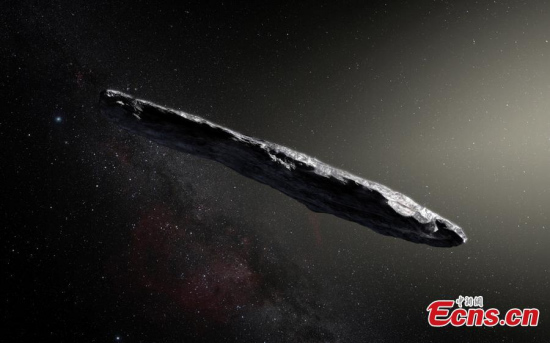
Artist's concept of interstellar asteroid 1I/2017 U1 (‘Oumuamua) as it passed through the solar system after its discovery in October 2017. The asteroid, named ‘Oumuamua by its discoverers, is up to one-quarter mile (400 meters) long and highly-elongated-perhaps 10 times as long as it is wide. That aspect ratio is greater than that of any asteroid or comet observed in our solar system to date. (Photo/Agencies)
American and French astrophysicists explained how can "Oumuamua," the first interstellar object ever seen in our solar system, get its long, thin cigar-like shape, resembling an airship in sci-fi movies.
The new study, published on Tuesday in the journal Monthly Notices of the Royal Astronomical Society, is giving scientists a fresh perspective on the development of planetary systems.
"This object was likely ejected from a distant star system," said Elisa Quintana, an astrophysicist at American space agency NASA's Goddard Space Center.
On Oct. 19, 2017, astronomers at the University of Hawaii spotted an object zipping through our solar system at a very high speed. Scientists dubbed it Oumuamua, which means "a messenger from afar arriving first" in Hawaiian.
On Sept. 19, it sped past the Sun at about 315,400 kilometers per hour, fast enough to escape the Sun's gravitational pull and break free of the solar system, never to return.
According to the researchers, systems with giant planets in unstable orbits are the most efficient at ejecting these smaller bodies because as the giants shift around, they come into contact with more material. Systems that do not form giant planets rarely eject material.
Using simulations from previous research, the paper's lead author Sean Raymond, an astrophysicist at the French National Center for Scientific Research, and his colleagues have shown that a small percentage of objects get so close to gas giants as they're ejected that they should be torn into pieces.
The researchers believe the strong gravitational stretching that occurs in these scenarios could explain Oumuamua's long, thin cigar-like shape.
The researchers calculated the number of interstellar objects we should see, based on estimates that a star system likely ejects a couple of Earth-masses of material during planet formation.
They estimated that a few large comets or asteroids will hold most of that mass but will be outnumbered by smaller fragments like Oumuamua.
"Even though this object was flying through our solar system, it does have implications for extrasolar planets and finding other Earths," Quintana said.


















































